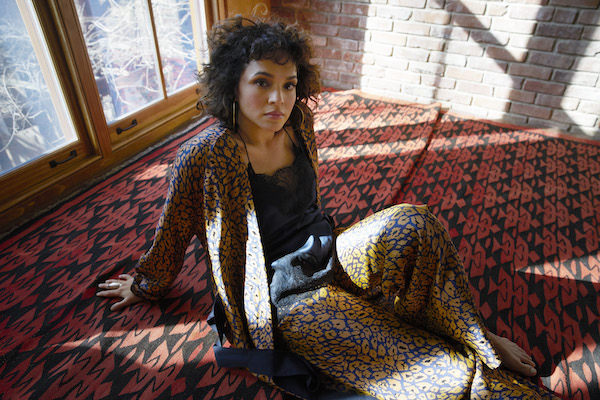Oct 28, 2025 10:47 AM
In Memoriam: Jack DeJohnette, 1942–2025
Jack DeJohnette, a bold and resourceful drummer and NEA Jazz Master who forged a unique vocabulary on the kit over his…

During the past 18 years, Norah Jones has collaborated with musicians from a range of different genres.
(Photo: Diane Russo)The initial session, with pianist, producer and old friend Thomas Bartlett, yielded three songs in two days, the first of which, the plaintive “My Heart Is Full,” was released as a single and appeared on the 2019 EP Begin Again.
The follow-up sessions, three days with Blade and bassist Chris Thomas, produced seven songs—three each appearing on Begin Again and Pick Me Up Off The Floor. The seventh song will be a bonus track. (At press time, the album’s release was slated for June 12.)
A bevy of other musicians have played at various sessions, with strings or horns overdubbed. Most of the sessions have been in Brooklyn, where Jones lives, and Manhattan. The outliers were three days in Chicago with Tweedy, which yielded four songs—two of which appear on Pick Me Up Off The Floor.
“It got to be a bit of a stockpile,” Jones said of the tracks she accumulated. “But then they kind of all connected. The songs fit together; they wanted to be together. They all stand on their own, but I felt like they had a thread that worked.”
Given Jones’ reluctance to discuss her lyrics’ meaning, identifying a narrative thread on the new album is necessarily a speculative endeavor. Still, the sequencing of the tracks was quite deliberate, according to Was: “It’s safe to assume nothing was unintentional.”
From the opener, “How I Weep,” a spare vocal supported only by piano, cello and viola, the narrative is heavy going. The song begins with lines that tell the tale: “How I/ How I/ Weep for the loss/ And it creeps down my chin/ For the heart and the hair/ And the skin and the air.” It closes with three repetitions of the title. There is no relief, comic or otherwise, in between.
The second tune, “Flame Twin,” proceeds along the same downcast lines, though the atmospherics are different. The trio locates a swampy groove, anchored by Patitucci’s electric bass and buttressed by Pete Remm’s Hammond B-3 organ and electric guitar—all of it intensified by the simpatico between Patitucci and Blade, longtime bandmates in Shorter’s acclaimed quartet. Lyrically, the piece summons an image of conflagration: “My twin, in flames.”
The bleakness of the material, made all the more powerful by Jones’ rejection of pyrotechnics, turns to desolation in the succeeding tracks—“Hurts To Be Alone,” “Heartbroken, Day After,” “Say No More.” But on the sixth track, “This Life,” the mood begins to brighten. Backed by Jones’ lush piano chords, the lyrics’ emptiness is tempered by a stack of vocal harmonies that seems divinely inspired.
With the next tune, “To Live,” the narrative itself starts to shift, placing Jones in a more resolute frame of mind. Operating in gospel mode and buoyed by Dave Guy’s trumpet and Leon Michels’ tenor saxophone, she declaims, “I’ll live in this moment/ And find my true place.”
The following track, the Tweedy collaboration “I’m Alive,” invokes the affirmative title eight times in the penultimate stanza. It completes a subset of three contiguous, life-themed songs.
Meanwhile, the album closer—the other Tweedy collaboration, “Heaven Above”—weaves its story around the celestial allusion of the title, with Jones taking her sole turn on celeste. Sonically, the tune ends the collection much as it started—in meditative mode, absent of drums and with Jones’ voice rising above a bed of strings (in this case, Tweedy’s electric and acoustic guitars). But in the lyrics, it provides a far more positive message.
Jones said the shift in tone from the pessimistic to the providential is intended to moderate the despair: “I didn’t want it to sink into a hole of depression by the end of the record. I wanted it to somehow uplift a little bit toward the end.”
Truth be told, some form of melancholy seems to have informed—and, in some cases, inspired—Jones’ musical life at least since the summer of 1999, when she migrated to New York City from Texas, where she had grown up and was preparing to be a jazz musician.
“When I moved to New York, I was homesick for Willie Nelson and country music,” she recalled. “I started changing. I started playing gigs with Jesse [Harris, who wrote “Don’t Know Why,” Jones’ biggest hit single] and Lee Alexander on bass, and we were all writing songs. And I started singing their songs and throwing a couple of mine in, and that’s what became Come Away With Me.”

Jack DeJohnette boasted a musical resume that was as long as it was fearsome.
Oct 28, 2025 10:47 AM
Jack DeJohnette, a bold and resourceful drummer and NEA Jazz Master who forged a unique vocabulary on the kit over his…

Goodwin was one of the most acclaimed, successful and influential jazz musicians of his generation.
Dec 9, 2025 12:28 PM
Gordon Goodwin, an award-winning saxophonist, pianist, bandleader, composer and arranger, died Dec. 8 in Los Angeles.…

Nov 13, 2025 10:00 AM
For results of DownBeat’s 90th Annual Readers Poll, complete with feature articles from our December 2025 issue,…

Flea has returned to his first instrument — the trumpet — and assembled a dream band of jazz musicians to record a new album.
Dec 2, 2025 2:01 AM
After a nearly five-decade career as one of his generation’s defining rock bassists, Flea has returned to his first…

To see the complete list of nominations for the 2026 Grammy Awards, go to grammy.com.
Nov 11, 2025 12:35 PM
The nominations for the 2026 Grammy Awards are in, with plenty to smile about for the worlds of jazz, blues and beyond.…








